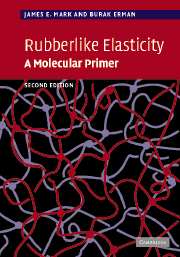Book contents
- Frontmatter
- Contents
- Preface to the first edition
- Preface to the second edition
- Part I Fundamentals
- 1 Introduction
- 2 Some rubberlike materials
- 3 The single molecule: theory and experiment
- 4 Preparation and structure of networks
- 5 Elementary statistical theory for idealized networks
- 6 Statistical theory for real networks
- 7 Elastic equations of state and force–deformation relations
- 8 Swelling of networks and volume phase transitions
- 9 Force as a function of temperature
- 10 Model elastomers
- Part II Additional topics
- Appendix A Relationships between ν, ξ and Mc
- Appendix B Relationships between 〈r2〉, 〈(Δr)2〉, 〈r2〉0, and ϕ
- Appendix C Equations of state for miscellaneous deformations from the constrained junction theory
- Appendix D Thermodynamics of the relationship of stress to temperature
- Problems
- Answers to problems
- Some publications describing laboratory/classroom experiments or demonstrations
- References
- Index
5 - Elementary statistical theory for idealized networks
from Part I - Fundamentals
Published online by Cambridge University Press: 04 December 2009
- Frontmatter
- Contents
- Preface to the first edition
- Preface to the second edition
- Part I Fundamentals
- 1 Introduction
- 2 Some rubberlike materials
- 3 The single molecule: theory and experiment
- 4 Preparation and structure of networks
- 5 Elementary statistical theory for idealized networks
- 6 Statistical theory for real networks
- 7 Elastic equations of state and force–deformation relations
- 8 Swelling of networks and volume phase transitions
- 9 Force as a function of temperature
- 10 Model elastomers
- Part II Additional topics
- Appendix A Relationships between ν, ξ and Mc
- Appendix B Relationships between 〈r2〉, 〈(Δr)2〉, 〈r2〉0, and ϕ
- Appendix C Equations of state for miscellaneous deformations from the constrained junction theory
- Appendix D Thermodynamics of the relationship of stress to temperature
- Problems
- Answers to problems
- Some publications describing laboratory/classroom experiments or demonstrations
- References
- Index
Summary
As was mentioned in Chapter 1, the elementary molecular theory of polymer networks rests on the postulate that the elastic free energy of a network is equal to the sum of the elastic free energies of the individual chains. The elastic free energy for the single chain was discussed in Chapter 3. Intermolecular contributions to the total elastic free energy are assumed to be insignificant and are entirely neglected in the elementary theory (Flory, 1953; Treloar, 1975). Understanding of the theory thus requires a precise description of the statistical behavior of the individual chains, given in Chapter 3, and of the relationship between their dimensions and the macroscopic strain that will be discussed in this chapter.
The chains in a network formed in the amorphous bulk state exhibit unperturbed dimensions identical to that of a single chain in Θ-solvents (Flory, 1953; Flory, 1976). This results from the fact that the distribution of the end-to-end vectors r for the chains in the bulk state is unchanged upon formation of network junctions, i.e., extended chains in the bulk state are equally susceptible to the interlinking or cross-linking reaction as others. The distribution of the end-to-end vector r of the chains in the network may therefore be identified with that of the single free chain. In rubber networks, chains that join two cross links typically have 100 to 700 bonds (Flory, 1976).
Information
- Type
- Chapter
- Information
- Rubberlike ElasticityA Molecular Primer, pp. 49 - 54Publisher: Cambridge University PressPrint publication year: 2007
Accessibility standard: Unknown
Why this information is here
This section outlines the accessibility features of this content - including support for screen readers, full keyboard navigation and high-contrast display options. This may not be relevant for you.Accessibility Information
- 1
- Cited by
